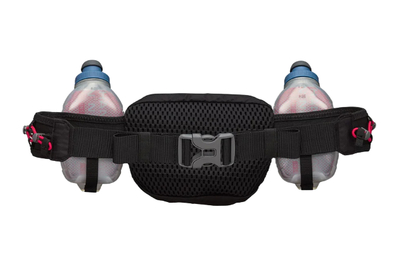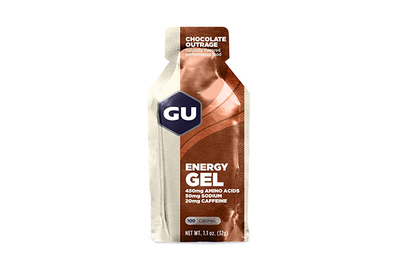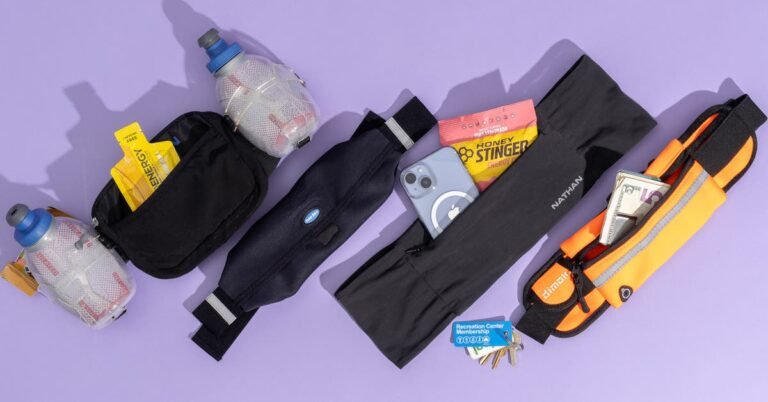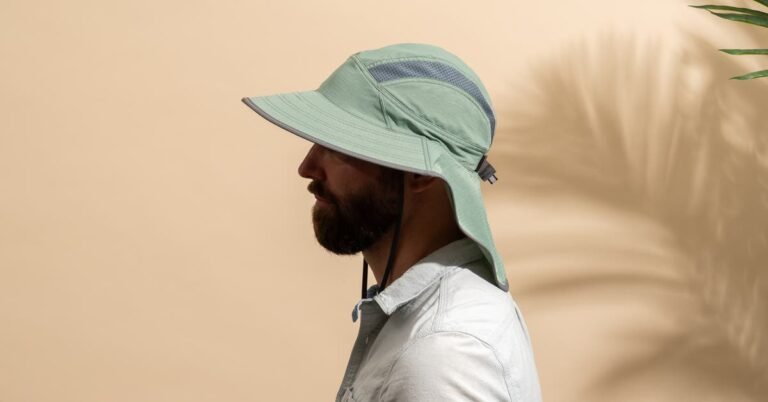
Water bottle/hydration system
Running with a water supply can help prevent dehydration and make longer runs a bit easier. We’ve found that the ideal water bottle for runners should hold at least 16 ounces of liquid, which in our experience is enough for up to two hours of running in moderate temperatures. (Hydration needs depend on factors like individual sweat rate, workout intensity, and weather; however, for long runs or races, experts recommend consuming 13 to 27 ounces of water per hour.)
Choosing between waist- and hand-mounted options is a matter of personal preference. Many people prefer a handheld bottle because waist packs can ride up or shift position during running. However, a waist pack can usually carry more water than a handheld bottle, and some people don’t like carrying things in their hands for an hour or more. We’ve tested nearly 20 different water bottles meant for use on runs.
If you’re looking for regular-size water bottles for after a run (or any other time), take a look at our full guide to the best water bottles.
Top pick
The Nathan TrailMix Plus 3.0 Insulated Hydration Belt comes with two insulated, 10-ounce bottles that we found kept water quite cool after 30 minutes of activity, even in the summer. A large pocket, a zippered pocket, and shock cords allow for lots of storage options. The belt’s clasp feels secure, and the band is easy to adjust while you are in motion. The belt comes with a 60-day satisfaction guarantee.
Energy gel
If you’re running for less than an hour, just drinking water is totally fine. But to sustain peak performance and boost endurance during long runs (from 60 to 90-plus minutes), nutritionists recommend that runners consume additional hydration, carbohydrates, and electrolytes. Fuel for runs falls into one of two categories: sports drinks, or water paired with energy bars, chews, blocks, or gels. After speaking with doctors, nutritionists, trainers, and marathon runners, we think gels offer the most portability, consistency, and convenience for daily training or competition running.
Sports drinks offer nutrition similar to gels, albeit in a less-portable package. “A gel is essentially a sports drink without the water,” said Matt Fitzgerald, certified sports nutritionist, coach, and author of numerous books, including How Bad Do You Want It?: Mastering the Psychology of Mind over Muscle and Run Like a Pro (Even If You’re Slow). “Functionally, they’re not that much different, but obviously a sports drink, it’s high volume and it’s heavy, and so it’s harder to carry.” A 12-ounce bottle of Gatorade has 21 grams of carbohydrates, about the same as a single gel packet. But if you’re following the recommendation to consume 30 to 60 grams of carbohydrate per hour during high-intensity efforts lasting longer than 60 minutes, you’d have to drink nearly three bottles of Gatorade an hour, which for many runners is a lot to consume.
Top pick
Gels, when consumed with water, offer an easy-to-digest combination of electrolytes (such as sodium and potassium) and carbohydrates (in the form of sugars like fructose and maltodextrin, a type of glucose). The best gel for you is a matter of personal preference, but we’re confident in recommending GU Original Energy Gel as a good starting point. GU offers the best overall nutrition, variety of flavors, availability, and affordability (around $1.50 per packet). That means you’re likely to find a flavor you don’t abhor (none are particularly delicious), and it’s likely to remain easy to find so you can train with it—an important factor for preventing gastrointestinal surprises on race day.
The original GU gel comes in 16 flavors, and you can start with a variety pack if you’re curious enough to try a bunch.
The gels contain a blend of maltodextrin and fructose, which is key to sustaining nutrition while you’re exercising. Fitzgerald explained to us why this is important: “Different types of sugars are processed or absorbed through different channels,” he said. “You can actually absorb more total carbohydrates if you have different types of carbs going into your body through different channels, because your body can multitask or parallel-process to get more sugar in.”
Some people have digestive issues with specific gel brands, but usually they can keep trying other brands until they find one that agrees with them. If GU doesn’t work for you and you want to explore the huge variety of gels out there, Jonathan Savage, a runner and blogger who helms the website fellrnr.com, has an extensive chart detailing all the nutritional aspects of gels. Ultimately, the nutritional differences from gel to gel are pretty slight, and GU gels are solidly in the middle of the pack. GU also has a line of gels called Roctane Energy, which have additional sodium and amino acids beyond the standard Original Energy Gels, but they’re nearly twice as expensive as the regular ones.
Source link
[og_img

Water bottle/hydration system
Running with a water supply can help prevent dehydration and make longer runs a bit easier. We’ve found that the ideal water bottle for runners should hold at least 16 ounces of liquid, which in our experience is enough for up to two hours of running in moderate temperatures. (Hydration needs depend on factors like individual sweat rate, workout intensity, and weather; however, for long runs or races, experts recommend consuming 13 to 27 ounces of water per hour.)
Choosing between waist- and hand-mounted options is a matter of personal preference. Many people prefer a handheld bottle because waist packs can ride up or shift position during running. However, a waist pack can usually carry more water than a handheld bottle, and some people don’t like carrying things in their hands for an hour or more. We’ve tested nearly 20 different water bottles meant for use on runs.
If you’re looking for regular-size water bottles for after a run (or any other time), take a look at our full guide to the best water bottles.
Top pick
The Nathan TrailMix Plus 3.0 Insulated Hydration Belt comes with two insulated, 10-ounce bottles that we found kept water quite cool after 30 minutes of activity, even in the summer. A large pocket, a zippered pocket, and shock cords allow for lots of storage options. The belt’s clasp feels secure, and the band is easy to adjust while you are in motion. The belt comes with a 60-day satisfaction guarantee.
Energy gel
If you’re running for less than an hour, just drinking water is totally fine. But to sustain peak performance and boost endurance during long runs (from 60 to 90-plus minutes), nutritionists recommend that runners consume additional hydration, carbohydrates, and electrolytes. Fuel for runs falls into one of two categories: sports drinks, or water paired with energy bars, chews, blocks, or gels. After speaking with doctors, nutritionists, trainers, and marathon runners, we think gels offer the most portability, consistency, and convenience for daily training or competition running.
Sports drinks offer nutrition similar to gels, albeit in a less-portable package. “A gel is essentially a sports drink without the water,” said Matt Fitzgerald, certified sports nutritionist, coach, and author of numerous books, including How Bad Do You Want It?: Mastering the Psychology of Mind over Muscle and Run Like a Pro (Even If You’re Slow). “Functionally, they’re not that much different, but obviously a sports drink, it’s high volume and it’s heavy, and so it’s harder to carry.” A 12-ounce bottle of Gatorade has 21 grams of carbohydrates, about the same as a single gel packet. But if you’re following the recommendation to consume 30 to 60 grams of carbohydrate per hour during high-intensity efforts lasting longer than 60 minutes, you’d have to drink nearly three bottles of Gatorade an hour, which for many runners is a lot to consume.
Top pick
Gels, when consumed with water, offer an easy-to-digest combination of electrolytes (such as sodium and potassium) and carbohydrates (in the form of sugars like fructose and maltodextrin, a type of glucose). The best gel for you is a matter of personal preference, but we’re confident in recommending GU Original Energy Gel as a good starting point. GU offers the best overall nutrition, variety of flavors, availability, and affordability (around $1.50 per packet). That means you’re likely to find a flavor you don’t abhor (none are particularly delicious), and it’s likely to remain easy to find so you can train with it—an important factor for preventing gastrointestinal surprises on race day.
The original GU gel comes in 16 flavors, and you can start with a variety pack if you’re curious enough to try a bunch.
The gels contain a blend of maltodextrin and fructose, which is key to sustaining nutrition while you’re exercising. Fitzgerald explained to us why this is important: “Different types of sugars are processed or absorbed through different channels,” he said. “You can actually absorb more total carbohydrates if you have different types of carbs going into your body through different channels, because your body can multitask or parallel-process to get more sugar in.”
Some people have digestive issues with specific gel brands, but usually they can keep trying other brands until they find one that agrees with them. If GU doesn’t work for you and you want to explore the huge variety of gels out there, Jonathan Savage, a runner and blogger who helms the website fellrnr.com, has an extensive chart detailing all the nutritional aspects of gels. Ultimately, the nutritional differences from gel to gel are pretty slight, and GU gels are solidly in the middle of the pack. GU also has a line of gels called Roctane Energy, which have additional sodium and amino acids beyond the standard Original Energy Gels, but they’re nearly twice as expensive as the regular ones.
The Best Running Gear of 2025
[title_words_as_hashtags







